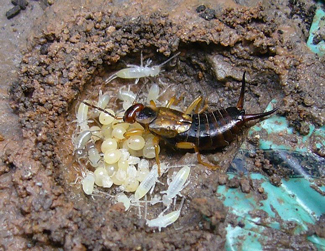What are earwigs?
By Chris Williams on June 3, 2015.

Female earwig with newly hatched young.
I remember as a kid sort of being creeped out a bit by earwigs. Mind you, I was a guy who used to ‘play’ with spiders, keep praying mantises for pets, go looking for monarch butterfly caterpillars, etc. but there was just something weird about earwigs. The neighborhood kids would call them ‘pincher bugs’ referring to the forceps-like cerci located at the posterior end of their body. They can give a pretty good pinch, but I figured out if you grabbed a hold of them by these, they couldn’t really hurt you. They have pretty small mouthparts too so they can’t do any damage if they bite.
What are they then? Earwigs belong to the order Dermaptera. This is a relatively small group of insects with only 22 species found in North America and just 1100 worldwide (Borror and White 1970), From a pest control perspective, they pretty much fall into the occasional invader category. They spend their time mostly outdoors in damp locations underneath mulch, or in leaf litter. When I was a kid, I’d find them living under flagstones or in rotted fence posts. They primarily feed on decaying plant material although they can occasionally be a pest on cultivated crops like flowers, fruits or vegetable. I find they seem to like my peach tree and will crawl up inside the fruits that have split. Earwigs are not a true structural pest in that they cause damage to homes, but rather are a nuisance pest that will wander inside during drier summer weather. I’ll find them in my basement living under entry mats or congregating beneath damp laundry.
The best non-chemical control measures for earwig include habitat modification around the home. Reducing damp areas around the home’s exterior by eliminating excess leaf litter and other clutter that is attractive to earwigs (they like to aggregate under objects) will make it difficult for them to thrive. Exterior perimeter treatments with residual insecticides should also be used to control or eliminate earwigs. Contact Colonial Pest Control for more information on our semi-annual service if you are having problems with earwigs.
The following references were used to create this article:
- Pests in Gardens and Landscapes: Earwigs – Agriculture and Natural Resources, University of California
- Earwigs – Iowa State University of Science and Technology
- European Earwigs – College of Agricultural Sciences at Penn State
- Borror, D. J and R. E White, 1970, A Field Guide To The Insects America North of Mexico.
Nabokov at en.wikipedia [CC BY-SA 3.0], from Wikimedia Commons
Stay up-to-date with Colonial Pest’s email newsletter!